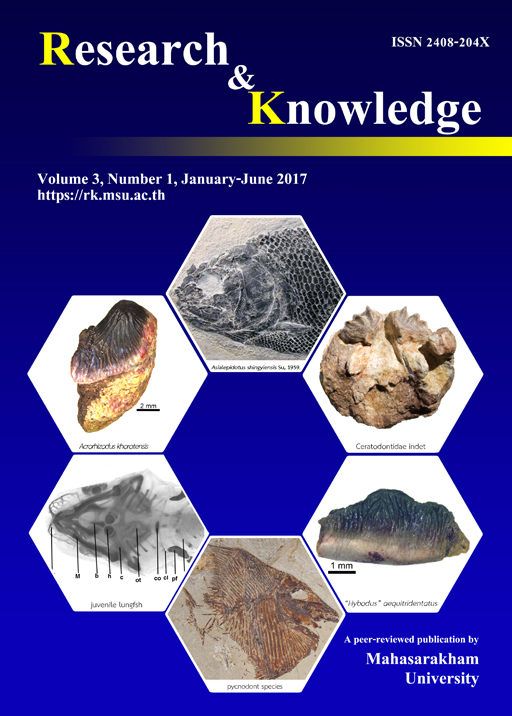Exceptional fossils from China highlight the origin and early diversification of ionoscopiform halecomorphs
Keywords:
Triassic, ionoscopiformes, osteology, phylogeny, South ChinaAbstract
Ionoscopiformes, sister to Amiiformes, are an extinct group of marine halecomorphs. In the past decades, ionoscopiforms were known from the Late Jurassic of Europe and the Early Cretaceous of the New World. Here, we introduce the fourth ionoscopiform known from China, Subortichthys triassicus Ma and Xu, 2017 from the early Middle Triassic (Pelsonian, Anisian) of Luoping, Yunnan Province. This paper summarizes information on the osteology of Robustichthys, Subortichthys and Panxianichthys based on well-preserved specimens. The new material reveals that the earliest diversification of ionoscopiforms was well underway in South China by the early Middle Triassic (Anisian).
References
Alvarado-Ortega, J. and Espinosa-Arrubarrena, L. 2008. A new genus of ionoscopiform fish (Halecomorphi) from the Lower Cretaceous (Albian) lithographic limestones of the Tlayúa quarry, Puebla, México. Journal of Palentology 82, 163–175.
Applegate, S. P. 1988. A new genus and species of a holostean belonging to the family Ophiopsidae, Teoichthys kallistos, from the Cretaceous near Tepexi de Rodríguez, Puebla. Revista mexicana de ciencias geológicas 7, 200–205.
Arratia, G. 2013. Morphology, taxonomy, and phylogeny of Triassic pholidophorid fishes (Actinopterygii, Teleostei).Journal of Veterbrate Palentology 33(suppl.1), 1–138.
Bartram, A. W. H. 1975. The holostean fish genus Ophiopsis Agassiz. Zoological Journal of the Linnean Society 56, 183–205.
Benton, M. J., Zhang, Q. -Y., Hu, S. -X., Chen, Z. -Q., Wen, W., Liu, J., Huang, J. -Y., Zhou, C. -Y., Xie, T., Tong, J. -N. and Choo, B. 2013. Exceptional vertebrate biotas from the Triassic of China, and the expansion of marine ecosystems after the Permo-Triassic mass extinction. Earth-Science Reviews 125. 199–243.
Brito, P. M. 2000. A new halecomorph with two dorsal fins, Placidichthys bidorsalis n. g., n. sp. (Actinopterygii: Halecomorphi) from the Lower Cretaceous of the Araripe Basin, northeast Brazil. Comptes Rendus de l’Académie des Sciences-Series IIA-Earth and Planetary Science 331, 749–754.
De Alessandri, G. 1910. Studii sui pesci Triasici della Lombardia. Memoria délia Società Italiana di Scienze Naturali 7, 1–145.
Grande, L. 2010. An empirical synthetic pattern study of gars (Lepisosteiformes) and closely related species, based mostly on skeletal anatomy. The resurrection of holostei. Copeia 10(Supplement), 1–871.
Grande, L and Bemis, W. E. 1998. A comprehensive phylogenetic study of amiid fishes (Amiidae) based on comparative skeletal anatomy: an empirical search for interconnected patterns of natural history. Journal of Vertebrate Paleontology 18 (Suppl.), 1–690.
Lane, J. A. and Ebert, M. 2012. Revision of Furo muensteri (Halecomorphi, Ophiopsidae) from the Upper Jurassic of western Europe, with comments on the genus. Journal of Vertebrate Palentology 32, 799–819.
Lane, J. A. and Ebert, M. 2015. A taxonomic reassessment of Ophiopsis (Halecomorphi, Ionoscopiformes), with a revision of Upper Jurassic species from Solnhofen Archipelago, and a new genus of Ophiopsidae. Journal of Vertebrate Palenotology 35, e883238.
López-Arbarello, A., Stockar, R. and Bürgin, T. 2014. Phylogenetic relationships of the Triassic Archaeo-semionotus Deecke (Halecomorphi, Ionoscopiformes) from the ‘Perledo Fauna’. PLoS ONE 9, e108665.
Ma, X. Y. and Xu, G. H. 2017. A new ionoscopiform fish (Holostei: Halecomorphi) from the Middle Triassic (Anisian) of Yunnan, China. Vertebrata PalAsiatica 55, 92–106.
Machado, G. P., Alvarado-Ortega, J., Machado, L. P. and Brito, P. M. 2013. Teoichthys brevipina, sp. nov., a new ophiopsid fish (Halecomorphi, Ionoscopiformes) from the Lower Cretaceous Tlayúa Formation, Central Mexico. Journal of Vertebrate Palenotology 33, 482–487.
Maisey, J. G. 1991. Santana Fossils: an Illustrated Atlas. T. F. H. Publications, Neptune City, New Jersey, pp. 1–459.
Patterson, C. 1973. Interrelationships of holosteans. In: Greenwood, P. H., Miles, R. S. and Patterson, C. (eds). Interrelationships of Fishes. Academic Press, London, pp. 233–305.
Schaeffer, B. 1960. The Cretaceous holostean fish Macrepistius. American Museum novitiates 2011, 1–18.
Schaeffer, B. 1971. The braincase of the holostean fish Macrepistius, with comments on neurocranial ossification in the Actinopterygii. American Museum novitiates 2459, 1–34.
Sieber, R. 1955. Ein bemerkenswerter Fischfund aus der Mitteltrias Kärtens. Carinthia 2, 91–96.
Sun, Z. -Y., Tintori, A., Xu, Y. -Z., Lombardo, C, Ni, P. -G. and Jiang, D. -Y. 2017. A new non-parasemionotiform order of the Halecomorphi (Neopterygii, Actinopterygii) from the Middle Triassic of Tethys. Journal of Systematic Palaeontology 15, 223–240.
Swofford, D. L. 2003. PAUP*. Phylogenetic Analysis Using Parsimony (*and Other Methods). Version 4.0b10. Sinauer Associates, Sunderland, Massachusetts.
Taverne, L. 2015. Osteology and phylogenetic relationships of Congophiopsis lepersonnei gen. nov. (Halecomorphi, Ionoscopiformes) from the Songa Limestones (Middle Jurassic, Stanleyville Formation), Democratic Republic of Congo. Geo-Eco-Trop 38, 223– 240.
Xu, G. -H. and Ma, X. -Y. in press. Taxonomic revision of Asialepidotus shingyiensis Su, 1959 (Halecomorphi, Holostei) from the Middle Triassic (Ladinian) of Guizhou and Yunnan, China. Research & Knowledge.
Xu, G. -H. and Shen, C. -C. 2015. Panxianichthys imparilis gen. et sp. nov., a new ionoscopiform (Halecomorphi) from the Middle Triassic of Guizhou, China. Vertebrata PalAsiatica 53, 1–15.
Xu, G. -H., Zhao, L. -J. and Coates, M. I. 2014. The oldest ionoscopiform from China sheds new light on the early evolution of halecomorph fishes. Biology letters 10, 20140204.
Downloads
Published
How to Cite
Issue
Section
License

This work is licensed under a Creative Commons Attribution-NoDerivatives 4.0 International License.







